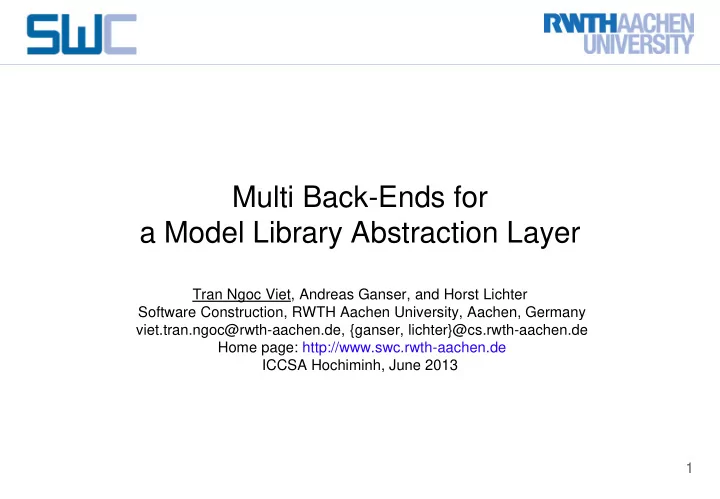

Multi Back-Ends for a Model Library Abstraction Layer Tran Ngoc Viet, Andreas Ganser, and Horst Lichter Software Construction, RWTH Aachen University, Aachen, Germany viet.tran.ngoc@rwth-aachen.de, {ganser, lichter}@cs.rwth-aachen.de Home page: http://www.swc.rwth-aachen.de ICCSA Hochiminh, June 2013 1
Motivation Recommender System Concept Realization Result and Future Work 2
Model Libraries Reuse is not a new term. Model reuse Challenges. Model reuse systems have model repositories. Not much research of storing mechanisms for models. 3
Motivation Recommender System Concept Realization Result and Future Work 4
Recommender System Model for Model Libraries supporting for multi-backends with different databases. Close the gap between servers (databases holding the models) and the local application. 5
Motivation Recommender System Concept Realization Result and Future Work 6
Model domain model LibraryElement has 3 attributes name, files and owner. LibraryElements could be grouped or categorized. Connectors present relationships of LibraryElements. Different mapping approaches for Connector. 7
Model Library Abstraction 8
Mapped Library Entities Objects and Elements (Vertices and Edges). Attributes and Properties. References and Edges. Connector objects are mapped with edges while others are mapped with vertices. ("David Beckham", 40000) ("Michael Owen", 50000) 9
Loading and Saving Mechanisms Divide the graph into subgraphs: How do we keep data of two subsets after cutting? How do we decide on a suitable cut-set? How do we keep the information of the cut-set? Load data in cut-set balls Return users what they exaclty need. Set the level of loading. Getting neighbors of a LibraryElement Save data which are changed. New objects or deleted objects. Track the changes on objects. 10
Motivation Recommender System Concept Realization Result and Future Work 11
EMF Code Generation 12
Data Strategy 13
Graph Streams Graph Input Stream Load graph elements into EMF Resources. Resources have URIs with parameters. No duplication. Graph Output Stream Update graphs from EMF Resources. Resources just hold which objects that the users want to update. 14
Object Graph Mapping Two directions: Programming objects to graph elements Graph elements to programming objects Avoid recursion in mapping Circles of references or connections Keep the mapping of object hashcodes and element ID 15
Loading and Saving Mechanisms The loading mechanism Find/Get graph elements based on property values and names. Create eObject from vertex. Put on a resource content list after mapping hashcode and id. Return to users what they need. The saving mechanism Put new or loaded but changed eObjects into content list. Create or find mapped vertices or edges, then fill vertices and edges. Map eObjects and vertices/edges. 16
Relational Strategy Configuration Hibernate: database and user parameters Teneo: mapping (inheritance, entities), names Initialize DataStore: Register Epackage (KnowledgeLibraryPackage) The saving process Support of Hibernate Session. 17
Motivation Recommender System Concept Realization Result and Future Work 18
Result and Future Work Result: Modeled the model libraries. Researched the Abstraction layer for MoCCa. Object Graph Mapping Interchangeable and extendable databases Reliable Loading and Saving Mechanisms for Graph Streams Efficient saving process with data limition in graph data streams. Future Work: Improve the loading and saving mechanisms. Simulate the graph traversal. Implement and test for other databases. Out of boundary of EMF. 19
Thank you! Time for Questions 20
Recommend
More recommend